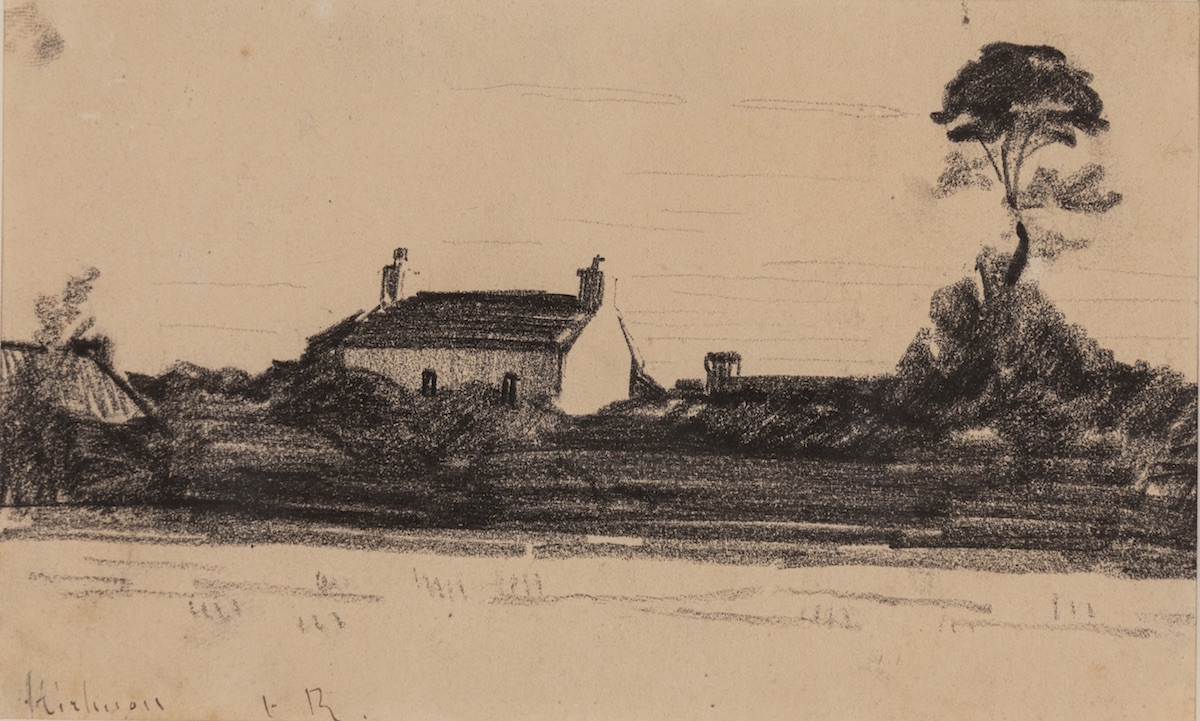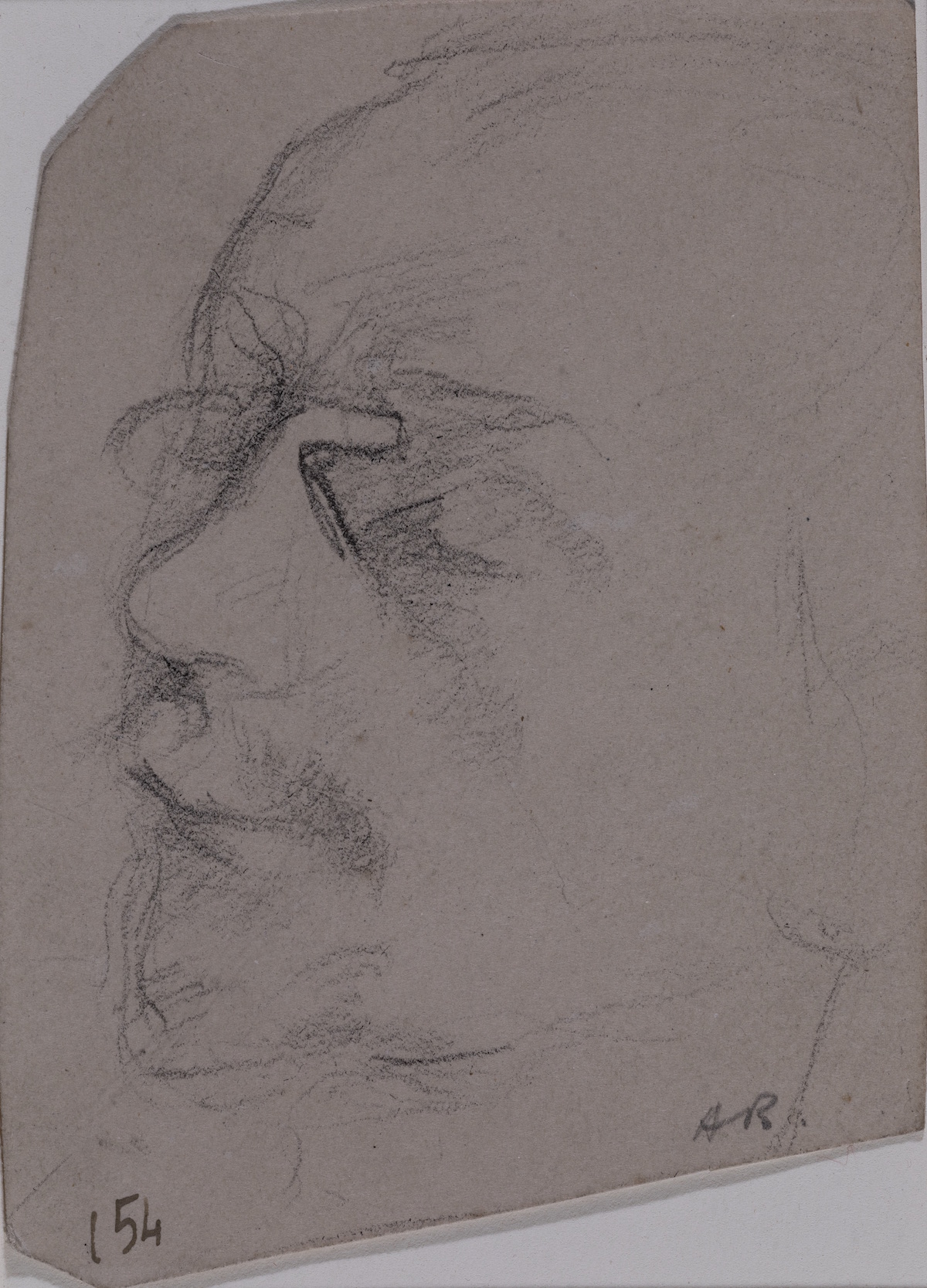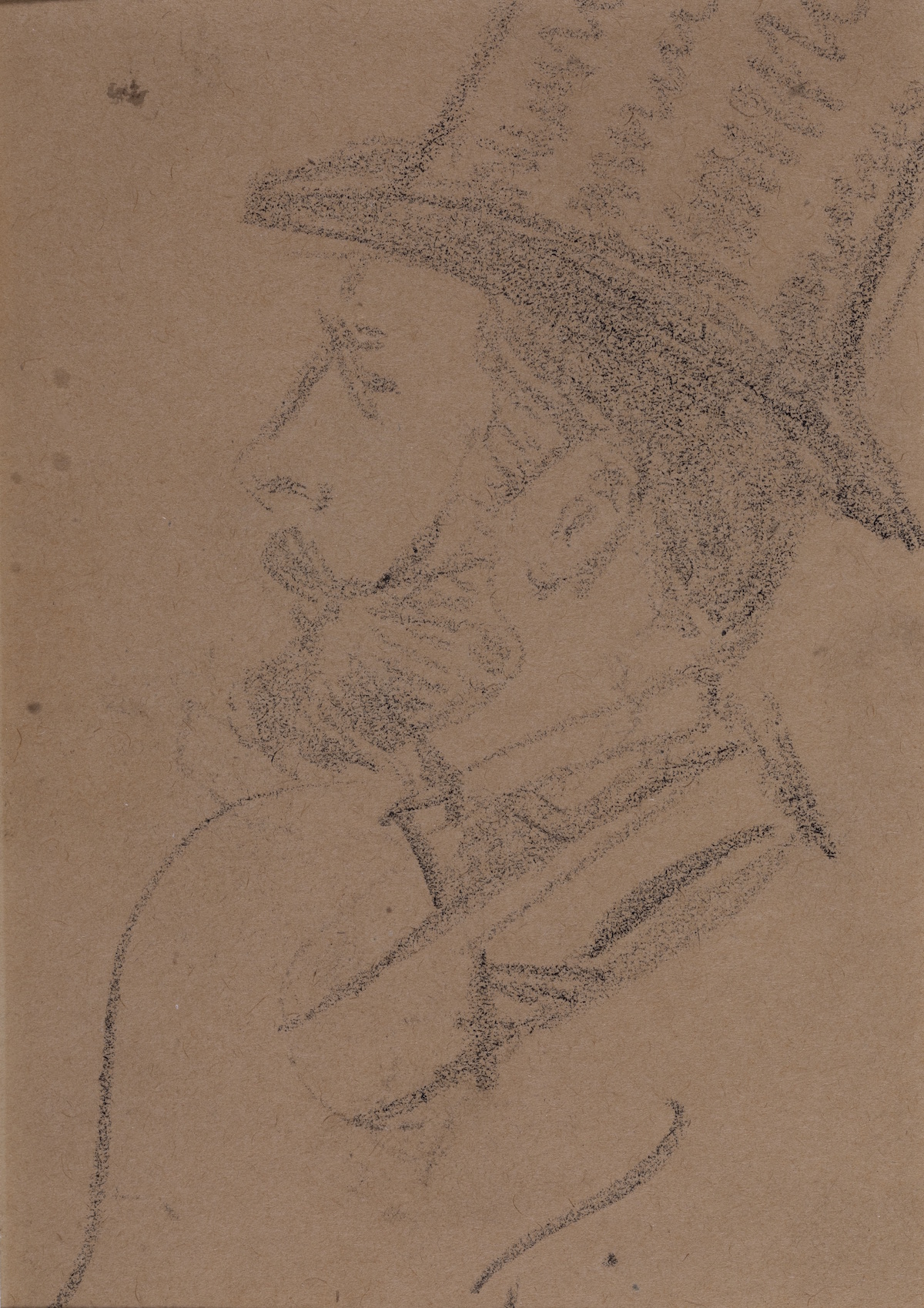Betts admired the great artists of the past. But most of the drawings he collected were by artists working around his lifetime. Contemporary drawings could be much cheaper to buy than Old Masters. They also had qualities that Betts appreciated. He was especially fond of artists who drew ordinary subjects taken from everyday life. Betts’ collecting continued to focus on artists drawing the body. Of the 68 drawings in the Betts Collection, there are only 7 landscapes. Betts selected studies that demonstrated distinct approaches to form, medium and technique. Some were by well-established names, like James Abbott McNeill Whistler (1834 – 1903). Others were by artists with whom Betts had personal and professional connections. Like Betts, Barnett Freedman (1901 – 1958) and John Piper (1903 – 1992) studied at the Royal College of Art.
Augustin Théodule Ribot, Landscape with a Farmhouse and Landscape with Trees, conté crayon, UAC/10560 and UAC/10561.
In these two small sketchbook drawings, outlines of trees and houses are set down on the horizon line in conté crayon. Detail is suggested through slight gradations in tone and the visible texture of the thick, waxy crayon. Ribot was part of the first generation of French landscape artists to reject idealised Italianate scenes in favour of natural observations. As demonstrated here, he left the studio behind to sketch directly from nature (en plein air).

The rugged textures of the rock increase in detail towards the centre of the page in this atmospheric sketch. Palmer visited Cornwall and Devon several times during this period, filling sketchbooks and producing highly finished watercolours. Exceptionally talented, he had been exhibiting work at the Royal Academy since the age of 14. He is best known for his “visionary” landscapes influenced by his friendship with the poet and painter William Blake (1757-1827).

Beyond the solid contour of the horizon line, the entire composition of this drawing is made up of dots and dashes in a pointillist style. It marks the beginnings of Pasmore’s experimentation with abstract art, in which he broke away from his earlier commitment to represent observed reality accurately. Instead, he began to experiment with form and colour. This drawing is preparatory study for the painting Suburban Gardens.

The Welsh-born Parisian artist Belleroche captured scenes of contemporary life, such as in this vibrant study of two women reading. Ink, applied exuberantly over visible pencil strokes, pools in blots that enhance the composition. Belleroche was a founder member of the 1903 Salon d’Automne. He exhibited there alongside the Impressionist and Post-Impressionist artists he moved among in Paris. His talent was recognized by his contemporary, Edgar Degas (1834-1917), who owned examples of his work.

The subject and composition of this drawing mimics the famous Card Players series by the French Post-Impressionist artist Paul Cezanne (1839-1906). Here, the game is checkers. The players’ heads and faces are sensitively and carefully recorded – in contrast to the looser and more fluid rendering of their bodies. The odd angle of the table plane as it extends back into space further evokes Cezanne’s use of distorted perspective.
Albert de Belleroche, Five studies from the Montparnasse Sketchbook, chalk/pencil, UAC/10550-UAC/10554.
An intimate portrait study of his life-long friend, artist Henri Toulouse-Lautrec (1864-1901), is included among these five sketchbook sheets documenting Belleroche’s regular visits to the Moulin Rouge. Betts acquired them from the artist’s son in 1956. Belleroche, who often shared workspaces with his other close friend and artist, John Singer Sargent (1856-1925), kept a studio opposite the Moulin Rouge. As heir to a rich, aristocratic family, his wealth freed him from having to accept commissions to support himself.

Forain began his career as a caricaturist for Paris journals. He was admired for the immediacy of his work and his ability to capture the qualities of different societal types. His drawings were highly prized. Together with Forain’s study of a Military Officer, this sheet belonged to the collection of Ambroise Vollard (1866–1939), Paris’ foremost dealer of twentieth-century French art. Vollard was a patron and champion of Forain along with Edgar Degas (1834-1917), Paul Cézanne (1839–1906) and many other artists.

Forain achieves maximum expressive effective with an absolute minimum of mark-making in this impactful drawing. The iconic shape of the figure’s bi-corn hat is expressed through six confident strokes of the pen. Its taut structure contrasts with the looser, crumpled form of the figure’s trousers – similarly expertly conveyed through a few crooked lines.

This late study of Whistler’s brother-in-law was drawn in a period of illness. Ronald Murray Philip accompanied Whistler to Algiers, Marseilles, and Corsica in the winter of 1900-1901. Whistler uses a scatter of dots and scratched lines to mark out the contour of the figure, and shades using parallel diagonal lines (of varying strengths and in both directions). These start from the hair and progress down over the body.

The Welsh painter John struggled for recognition in a male-dominated profession. She was known as August Rodin’s (1840-1917) lover, Augustus John’s (1878-1961) sister and a pupil of James Abbott McNeill Whistler (1834-1903). Today, she is celebrated for her introspective portraits of female sitters. This lightly drawn, unfinished study of the female nude is frank and sensual. It presents the model’s torso to the viewer’s gaze but keeps her identity hidden.

This sketch of the playwright and author, Mary Russell Mitford, was used for a cartoon in Fraser’s Magazine “Gallery of Literary Characters” in 1831. Maclise added a young boy, a sleeping dog, swoons of fabric and a window garlanded with flowers to the cartoon. Its domesticated, feminised caricature contrasts with the alert, intellectual character he captured in this drawing. A celebrated draughtsman, the Irish Maclise was the leading mid-19th century portrait painter in Britain.

Together with William Coldstream (1908–1987) and Claude Rogers (1907–1979), Pasmore founded the Euston Road School of Painting and Drawing in 1937. It promoted accessible subjects drawn accurately from life and taught a system of drawing based on careful measurement. Here, Coldstream is shown engrossed in the act of drawing. Dots and intersecting planes, used for points of reference, are visible throughout the sketch – including along Coldstream’s lapels and through the top of his head.

The free-spirited work of society portraitist McEvoy was in demand in the 1920s. Study for Phyllida shows his effective use of contrasting materials in works on paper. Broadly applied dark wash is juxtaposed against the stark white of the unshaded figure. Precise drawing picks out the facial features. Family friend, James Abbott McNeill Whistler (1834-1903), encouraged McEvoy to become an artist. He was a close associate (and possible lover) of Gwen John (1876-1939) and a travelling companion of Walter Sickert (1860-1942).

Freedman studied alongside Betts at the Royal College of Art before going on to work as an illustrator and official war artist. In 1928, he joined the staff of the Royal College, and shortly afterwards began to teach at the Ruskin School of Art, Oxford. The pose of this female model is seen in many traditional life drawings. However Freedman shifted away from the idealized body types, clean contours and careful shading of academic studies of the nude.

Best known for his topographical work, the British artist Piper was committed to life drawing throughout his career. Here, the model’s face is submerged in darkness built up through progressive layers of black ink and wash. Her exposed back highlights Piper’s rhythmic, spindly penwork. A streak of white gouache, also applied as a ghostly wash to the model’s face, is interrupted by the red blot of her lipstick. Betts bought this drawing “from the artist personally” when Piper was a visiting artist at Reading School of Art in 1956.






